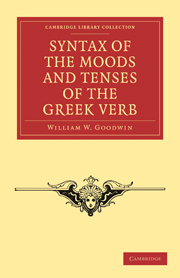Book contents
- Frontmatter
- PREFACE TO THE SECOND EDITION
- Contents
- CHAPTER I GENERAL VIEW OF THE MOODS
- CHAPTER II USE OF THE TENSES
- CHAPTER III THE PARTICLE ῞AN
- CHAPTER IV USE OF THE MOODS
- CHAPTER V THE INFINITIVE
- CHAPTER VI THE PARTICIPLE
- CHAPTER VII VERBAL ADJECTIVES IN -τέος
- APPENDIX I
- APPENDIX II
- INDEX TO EXAMPLES
- ENGLISH INDEX
- GREEK INDEX
CHAPTER I - GENERAL VIEW OF THE MOODS
Published online by Cambridge University Press: 07 September 2011
- Frontmatter
- PREFACE TO THE SECOND EDITION
- Contents
- CHAPTER I GENERAL VIEW OF THE MOODS
- CHAPTER II USE OF THE TENSES
- CHAPTER III THE PARTICLE ῞AN
- CHAPTER IV USE OF THE MOODS
- CHAPTER V THE INFINITIVE
- CHAPTER VI THE PARTICIPLE
- CHAPTER VII VERBAL ADJECTIVES IN -τέος
- APPENDIX I
- APPENDIX II
- INDEX TO EXAMPLES
- ENGLISH INDEX
- GREEK INDEX
Summary
§ 1. The Greek very has five Moods, the Indicative, Subjunctive, Optative, Imperative, and Infinitive. The first four, as opposed to the Infinitive, are called finite moods.
§ 2. The Indicative is used in simple, absolute assertions; as γράφει, he writes; ἔγραψεν, he wrote; γράψει, he will write; γέγραφεν, he has written.
The Indicative is used also to express various other relations, which the following examples will illustrate:–
Εἰ τοῦτο ἀληθές ἐστι, χαίρω, if this is true, I rejoice. Εἰ ἔγραψεν, ἦλθον ἄν, if he had written, I should have come. Εἰ τοῦτο ποιήσει, καλῶς ἕξει, if he shall do this, it will be well. Ἐπιμελεῖται ὅπως τοῦτο γενήσεται, he takes care that this shall happen. Εἴθε με ἔκτεινας, ὡς μήποτε τοῦτο ἐποίησα, O that thou hadst killed me, that I might never have done this! Εἴθε τοῦτο ἀληθὲς ἦν, O that this were true. ∧έγει ὡς τοῦτο ἀληθές ἐστιν, he says that this is true. Εἶπεν ὅτι τοῦτο πράξει, he said that he would do this. Ἑρωτᾷ τί ἐγράψαμεν, he asks what we wrote.
These constructions will be explained in Chapter IV. They are sufficient to show the impossibility of including all the uses of the Indicative in one definition. […]
- Type
- Chapter
- Information
- Syntax of the Moods and Tenses of the Greek Verb , pp. 1 - 3Publisher: Cambridge University PressPrint publication year: 2010First published in: 1867

